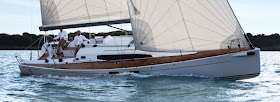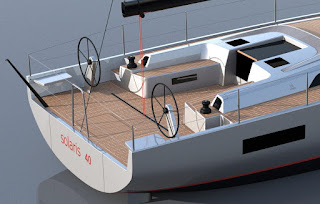Sadly and for understandable reasons the crowd that used to salute the sailors when they leave Sables-d'Ollone will not be there and the Vendée Globe Village was closed and the crowds cannot visit the race boats and talk with the skippers but I bet that this edition will be, by far, the one most audience.
Never so many competitive boats were racing on a Vendée: 13 were built in the last 5 years and 16 boats are between 9 and 13 years old, among them 10 redesigned with foils and only 3 boats with 20 years or more. The victory should come from one of the new boats all sailed by very experienced sailors with the exception of Kojiro Shiraishi who sails a 2019 VPLP.
Also designed by VPLP, Charal (2018) sailed by Jérémie Beyou, Hugo Boss (2019) sailed by Alex Thomson. Verdier designed two, Apivia (2019) sailed by Charlie Dalin and Linkedout (2019) sailed by Thomas Ruyant. JK designed also two, Arkea-Paprec (2019) sailed by Sébastien Simon and Corum (2020) sailed by Nicolas Troussel and finally, Sam Manuard designed the last of the new boats, L'Occitane (2020), sailed by Armel Tripon.
On the last race ( Vendée-Arctique) Samantha Davis showed that she and Initiatives Coeur (2010-VPLP-Verdier), one of the boats that were redesigned with foils could be almost as fast as the new boats, in fact, she was way faster than Kojiro Shiraishi on a new boat as well as Kevin Escoffier PRB (2009 -VPLP-Verdier) that arrived close to Samantha showing that they can fight, probably not for the victory but for a podium place.
L'Ocittane designed by Sam Manuard and sailed by Armel Tripon, the last to be launched and the most radical of all Imocas, did not prove well, not being very fast at the beginning and soon damaged and forced to retire. The boat was repaired and we will see if it goes faster on the Vendée, even if I have some doubts.
It is said that the two best solo offshore sailors, Armel Le Cléac'h and Francois Gabart will not be racing, having chosen to race multihulls instead of monohulls. In this race the new generation will try to beat the "old-timers", the most experienced and legendary ones, Alex Thompson, Jérémie Beyou and Samantha Davies and the best between the young guns seem to be Thomas Ruyant and Charlie Dalin.
Charlie comes from the Figaro where he was a champion and learned the ropes on the IMOCA class with Yann Eliès one of the best ever on the Figaro, but not very lucky on the bigger boats. Thomas Ruyant has a different formation, first a top mini-racer sailor, then a top 40 class racer and then making the last Vendée on an old boat, sailing fast and refusing to abandon his boat even when it was almost broken in two, managing to bring it to NZ. You can recall that incredible story here:
https://interestingsailboats.blogspot.com/2016/12/more-drama-on-vendee-globe.html
https://interestingsailboats.blogspot.com/2016/12/what-do-you-call-drama-with-happy-end.html
Now, the public attention he got allowed him to have more sponsorship and a new boat. On this Vendée, he is there not only to show what he is capable to do, but to try to win the race.
The Vendée will start at 1.02PM, November 8th and as usual, will be transmitted live on many television channels, on Facebook and Twiter. There's also an App that you can download to follow the race. Here:
https://apps.apple.com/gb/app/vend%C3%A9e-globe-2020/id1531491499
https://play.google.com/store/apps/details?id=org.vendeeglobe.www.twa
As usual, I will follow the race here. After the Ocean Race unexpected postponement, this will be the biggest offshore sailing event of 2020/2021 and I say unexpected because these races are mostly followed on the internet, the crews spend most of the time at sea and in the case of the Ocean Race only minor adaptations and precautions would be needed for the race to take place.
I hope many of you choose to follow it with me enriching the blog with your comments, making it better and more fun.




















































